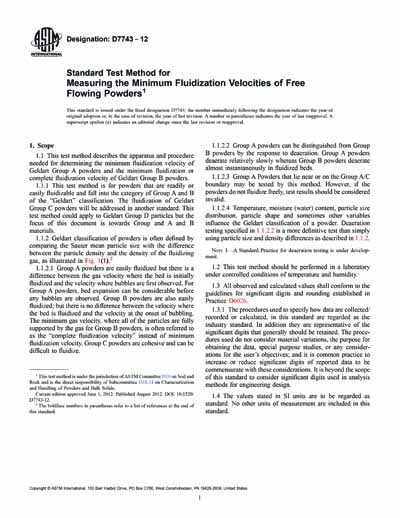Historical
ASTM D7743-12
Standard Test Method for Measuring the Minimum Fluidization Velocities of Free Flowing Powders
1.1 This test method describes the apparatus and procedure needed for determining the minimum fluidization velocity of Geldart Group A powders and the minimum fluidization or complete fluidization velocity of Geldart Group B powders.
1.1.1 This test method is for powders that are readily or easily fluidizable and fall into the category of Group A and B of the ???Geldart??? classification. The fluidization of Geldart Group C powders will be addressed in another standard. This test method could apply to Geldart Group D particles but the focus of this document is towards Group and A and B materials.
1.1.2.1 Group A powders are easily fluidized but there is a difference between the gas velocity where the bed is initially fluidized and the velocity where bubbles are first observed. For Group A powders, bed expansion can be considerable before any bubbles are observed. Group B powders are also easily fluidized; but there is no difference between the velocity where the bed is fluidized and the velocity at the onset of bubbling. The minimum gas velocity, where all of the particles are fully supported by the gas for Group B powders, is often referred to as the ???complete fluidization velocity??? instead of minimum fluidization velocity. Group C powders are cohesive and can be difficult to fluidize.
1.1.2.2 Group A powders can be distinguished from Group B powders by the response to deaeration. Group A powders deaerate relatively slowly whereas Group B powders deaerate almost instantaneously in fluidized beds.
1.1.2.3 Group A Powders that lie near or on the Group A/C boundary may be tested by this method. However, if the powders do not fluidize freely, test results should be considered invalid.
1.1.2.4 Temperature, moisture (water) content, particle size distribution, particle shape and sometimes other variables influence the Geldart classification of a powder. Deaeration testing specified in 1.1.2.2 is a more definitive test than simply using particle size and density differences as described in 1.1.2.






